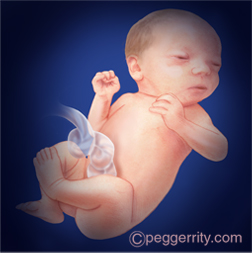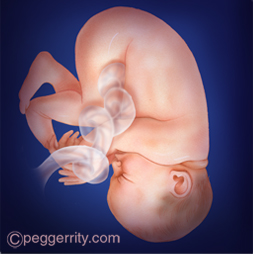Pregnancy Information and Resources
All about Pregnancy (English/Spanish)
The Office on Women's Health, part of the U.S. Department of Health and Human Services offers many print and online resources to help you have a healthy pregnancy and deliver a healthy baby. All information is available in English and Spanish here:
Stages of Pregnancy
First trimester (week 1-week 12)
At four to five weeks:

- Your baby's brain and spinal cord have begun to form.
- The heart begins to form.
- Arm and leg buds appear.
- Your baby is now an embryo and one-twenty-fifth inch long.
At eight weeks:

- All major organs and external body structures have begun to form.
- Your baby's heart beats with a regular rhythm.
- The arms and legs grow longer, and fingers and toes have begun to form.
- The sex organs begin to form.
- The eyes have moved forward on the face and eyelids have formed.
- The umbilical cord is clearly visible.
- At the end of eight weeks, your baby is a fetus and looks more like a human. Your baby is nearly 1 inch long and weighs less than one-eighth ounce.
At 12 weeks:

- The nerves and muscles begin to work together. Your baby can make a fist.
- The external sex organs show if your baby is a boy or girl. A woman who has an ultrasound in the second trimester or later might be able to find out the baby's sex.
- Eyelids close to protect the developing eyes. They will not open again until the 28th week.
- Head growth has slowed, and your baby is much longer. Now, at about 3 inches long, your baby weighs almost an ounce.
Second trimester (week 13-week 28)
At 16 weeks:

- Muscle tissue and bone continue to form, creating a more complete skeleton.
- Skin begins to form. You can nearly see through it.
- Meconium (mih-KOH-nee-uhm) develops in your baby's intestinal tract. This will be your baby's first bowel movement.
- Your baby makes sucking motions with the mouth (sucking reflex).
- Your baby reaches a length of about 4 to 5 inches and weighs almost 3 ounces.
At 20 weeks:

- Your baby is more active. You might feel slight fluttering.
- Your baby is covered by fine, downy hair called lanugo (luh-NOO-goh) and a waxy coating called vernix. This protects the forming skin underneath.
- Eyebrows, eyelashes, fingernails, and toenails have formed. Your baby can even scratch itself.
- Your baby can hear and swallow.
- Now halfway through your pregnancy, your baby is about 6 inches long and weighs about 9 ounces.
At 24 weeks:

- Bone marrow begins to make blood cells.
- Taste buds form on your baby's tongue.
- Footprints and fingerprints have formed.
- Real hair begins to grow on your baby's head.
- The lungs are formed, but do not work.
- The hand and startle reflex develop.
- Your baby sleeps and wakes regularly.
- If your baby is a boy, his testicles begin to move from the abdomen into the scrotum. If your baby is a girl, her uterus and ovaries are in place, and a lifetime supply of eggs have formed in the ovaries.
- Your baby stores fat and has gained quite a bit of weight. Now at about 12 inches long, your baby weighs about 1½ pounds.
Third trimester (week 29-week 40)
At 32 weeks:

- Your baby's bones are fully formed, but still soft.
- Your baby's kicks and jabs are forceful.
- The eyes can open and close and sense changes in light.
- Lungs are not fully formed, but practice "breathing" movements occur.
- Your baby's body begins to store vital minerals, such as iron and calcium.
- Lanugo begins to fall off.
- Your baby is gaining weight quickly, about one-half pound a week. Now, your baby is about 15 to 17 inches long and weighs about 4 to 4½ pounds.
At 36 weeks:

- The protective waxy coating called vernix gets thicker.
- Body fat increases. Your baby is getting bigger and bigger and has less space to move around. Movements are less forceful, but you will feel stretches and wiggles.
- Your baby is about 16 to 19 inches long and weighs about 6 to 6½ pounds.
Weeks 37–40:

- At 39 weeks, your baby is considered full-term. Your baby's organs are ready to function on their own.
- As you near your due date, your baby may turn into a head-down position for birth. Most babies "present" head down.
- At birth, your baby may weigh somewhere between 6 pounds 2 ounces and 9 pounds 2 ounces and be 19 to 21 inches long. Most full-term babies fall within these ranges. But healthy babies come in many different sizes.

